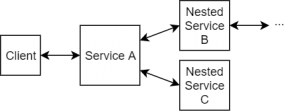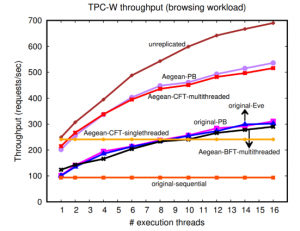One Page Summary. Aegean: Replication beyond the client-server model

This paper builds o
n a key observation about the operation of complex distributed applications. Namely, microservice style of application rarely follows a simple client-server architecture, where a client makes a request and the server (or servers) respond to a request. Instead, many applications often use a nested approach, where clients communicate with some service, and the service itself acts as a client for one or more other nested services. This nesting often presents some challenges with traditional replication protocols, like primary-backup or Paxos-based RSM replication. For instance, when a service is replicated for durability, it makes it more difficult to preserve correctness of nested requests: in case of service failure, the information on whether the nested request was issued or returned may have been lost without some additional safeguards, making it difficult to track whether nested requests need to be reissued or otherwise recovered. Authors also claim that the existing approaches, like Paxos, suffer from performance penalty when dealing with nested calls, since the replicated service needs to block and wait for nested calls to resolve. I personally do not buy the latter issue too much, as many existing replication solutions, even Paxos-based, try to take advantage or parallelism whenever possible, by either using a pipelined approach or concurrently operating on independent requests or data in different conflict domains.

To counter the problems with nested request calls and responses, Aegean proposes to use a shim layer sitting next to each replicated service. When one service creates a nested request to the other service, it will talk to the shim layer instead of the nested service directly. The shim layer runs at each replica of a replicated service and collects the requests coming from the caller service (it assumes each replica of the caller will send a request). The shim passes the request to the nested service replica only upon collecting the majority requests from the caller, ensuring that the caller has sufficiently replicated the nested request. The replica can then process/replicate requests. Similarly, when the nested service generates the response, the shim layer broadcasts the response to all replicas of the caller service, keeping track of caller replicas receiving the responses and resending them as needed. Additionally, to ensure the response durability, every replica of the caller service sends the ack to other replicas, and only acts on the responses from a nested call when it itself receives a majority of such acks (including its own). This ensures that the responses to a nested call have been logged by at least a majority of replicas in a service. All these shim layers and ensuring response durability create a lot more message exchange in the system, which undoubtedly will impact the performance.
Another aspect of the paper deals with speculative execution of some requests, as these also introduce problems in the context of nested microservices, as speculative state may leak and get exposed to other services in the nesting chain. Aegean solves the problem of speculation by using barriers before the speculative state may become visible and resolves the speculation by reset and reply if replicas arrived at a different state.

To solve the performance issues with sequential Paxos, Aegean proposes to use pipelined approach, which is definitely not new. For example, our Paxi from a few years back is a pipelined implementation of many consensus protocols. Authors claim that Aegean has decent performance, although I find the evaluation a bit lacking. The main comparison is against sequential (not pipelined) Paxos, and Aegean is doing well in this setting. However, even authors admit that a large portion of the difference is due to the pipelining, raising the question of whether the performance comparison is fair in the first place.
Overall, I enjoyed the problems caused by replication in nested microservice architecture, but I am not sure I am too excited about the solution. The solution is a solid one for sure, but it appears very piecewise, with every piece specifically targeting a sub-problem, so it lacks certain elegance (which is not a bad thing at all for a solid practical approach to a problem). The evaluation is one part that raises the most questions for me, ranging from claims that non-byzantine tolerant Paxos and PBFT have similar throughput, to picking inherently weak baselines for evaluation, like non-pipelined Paxos.